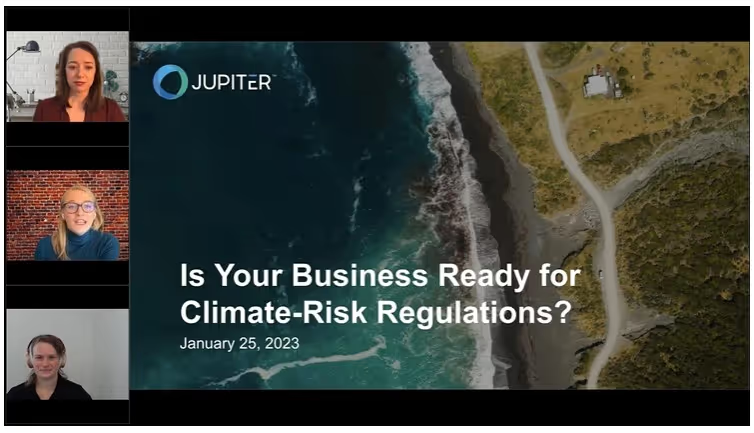
By Elisa Seith & Megan Arnold
Jupiter Intelligence
The world’s largest economies are rolling out new climate-risk disclosure regulations. Is your business prepared?
This unsettling question concerns more than compliance and ESG managers of organizations who do business in those economies. It touches risk managers, CROs, investor relations professionals, and heads of finance—not to mention key institutional and individual investors. It may even reach the C-suite.
The momentum for regulations that require more transparency from business in assessing and reporting climate risk vulnerability continues to build among global jurisdictions. Regulators are convinced that impacts of both acute and chronic physical climate risks, as well as transition risk, are material to businesses’ financial performance. In addition, their establishment of clearer rules for climate reporting brings both focus and urgency to sustainability initiatives within companies.
As the days pass, compliance deadlines grow nearer, and pressures build from stakeholders and the public that call on companies to make meaningful sustainability reporting.
So many businesses—perhaps yours—would answer the daunting question of Are we prepared? with a second one: Where do we start?
We’ve begun 2023 with a lively and well-attended Jupiter webinar that identifies a best-practices path for beginning the compliance process on the right foot. It can help lead to a climate journey that creates a more resilient, sustainable and successful future for your organization.
Watch, on-demand, Jupiter’s webinar: Is Your Business Ready for Climate-Risk Regulations?

Information, Preparation, Action
This is the second of two blogs that point to key takeaways from that webinar. In December, we previewed the evolving regulatory landscape through 2024. Becoming informed about these external pressures and applying how existing or proposed regulations will affect your region, industry, and business, represents a critical first step.
The next major steps call for discrete actions:
- To prepare by determining the substance and scope of your reporting needs,
- To begin collecting essential data from internal and external sources (such as climate data providers) based on those needs, and
- To conduct a thorough disclosure process in line with compliance deadlines.
Embarking On a Data-Driven Climate Risk Journey

Companies must take important early steps in data collection; the identification of assets and their physical locations (street addresses or geocoordinates), and precise asset-specific data, are essential to a meaningful, high-resolution analysis of physical risk impacts on those assets, loss modeling, resilience planning & prioritization, and more.
Businesses can take a data-driven, pragmatic, step-by-step approach to (1) physical climate risk disclosure, (2) risk management, and (3) resilience. Our webinar describes how and where the role of data is crucial to a reporting process (as shown above) and building maturity in the climate journey as a whole over time.
Jupiter as Your Climate Data Partner
Sourcing superior physical climate risk data is also a vital early task. Jupiter is uniquely able to help organizations meet regulatory requirements. With forward-focused, rigorous methodologies and best-in-class analytics, Jupiter turns sophisticated climate science into actionable data.
Jupiter addresses physical risk data needs common to the most influential reporting frameworks, including TCFD (Task Force on Climate-related Financial Disclosures), the EU Taxonomy, and CDP:
- Metrics for acute and chronic physical risk hazards (for example, we either directly model or offer risk drivers for 28 of the 33 physical hazards identified by the EU Taxonomy)
- Support of multiple climate emissions scenarios (SSP1-2.6, SSP2-4.5, and SSP5-8.5), and
- Short, medium and long-term timeframes (five-year increments from 2020 to 2100).
Jupiter ClimateScore™ Global’s portfolio-level (90 meters) resolution for all points on the Earth’s land surface enables a global analysis of owned assets at risk and supply chains; our ClimateScore Planning suite of analytics services for flood, wind, heat, and wildfire offer even higher-resolution projections for individual assets.
Importantly, we often work on a case-by-case basis to help our customers create their own compliance roadmap, and we support them along their entire climate journey.
Data informs and powers climate risk assessment, reporting, and resilience. Watch our webinar, reach out to us, and see ClimateScore Global in action.
Elisa Seith is a Jupiter Solutions Architect based in the United Kingdom.
Megan Arnold is Jupiter’s Regulatory and Competitive Intelligence Manager.
.webp)
